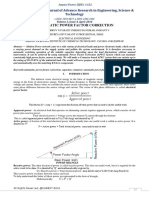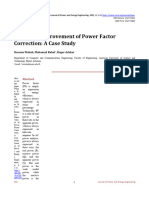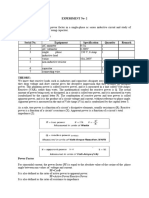B.
TECH SECOND YEAR, SESSION 2018-19
NETWORK ANALYSIS-II
Page # 1
Power Factor
Definitions:
1. The ratio between power utilized to power produce called Power Factor.
2. The Cosine of angle between Current and Voltage is called Power Factor, i.e.
P = VI Cosθ OR Cosθ = P / V I OR
Cosθ = kW / kVA i.e. Cosθ = True Power / Apparent Power.
3. The ratio between resistance and Impedance is Called Power Factor, i.e. Cosθ =
R/Z
4. The ratio between Actual Power and Apparent Power is called power factor,
i.e. Cosθ = kW / kVA
Active, Reactive, Apparent & Complex Power. Simple explanation with formulas.
(1) Real Power: (P)
➢ Alternative words used for Real Power (Actual Power, True Power, Watt-full Power,
Useful Power, Real Power, and Active Power)
➢ In a DC Circuit, power supply to the DC load is simply the product of Voltage across
the load and Current flowing through it i.e., P = V I. because in DC Circuits, there
is no concept of phase angle between current and voltage. In other words, there is
no Power factor in DC Circuits.
➢ But the situation is Sinusoidal or AC Circuits is more complex because of phase
difference between Current and Voltage. Therefore average value of power (Real
Power) is P = VI Cosθ is in fact supplied to the load.
Real Power formulas:
P=VI (In DC circuits)
P = VI Cosθ (in Single phase AC Circuits)
P = √3 VL IL Cosθ or (in Three Phase AC Circuits)
P = 3 VPh IPh Cosθ
P = √ (S2 – Q2) or
Composed, Compiled, & Revised By: ASIF ILTAF (Ex-ET/LT), Associate Professor (Electrical),
Department of B.Tech (Electrical), GCT Peshawar, Session 2015-16, Mob: 03005931328, email: asifiltaf74@gmail.com, Updated
on Feb, 2019. Reference Website: http://www.electricaltechnology.org/ & my own ideas
� B.TECH SECOND YEAR, SESSION 2018-19
NETWORK ANALYSIS-II
Page # 2
2 2
P =√ (VA – VAR ) or
Real or True power = √ (Apparent Power2– Reactive Power2) or KW = √
(KVA2 – KVAR2)
(2) Reactive Power: (Q)
➢ Also known as (Use-less Power, Watt less Power)
➢ The powers that continuously bounce back and forth between source and load is
known as reactive Power (Q)
➢ Power merely absorbed and returned in load due to its reactive properties is
referred to as reactive power
➢ The unit of Active or Real power is Watt where 1W = 1V x 1 A.
➢ Reactive power represent that the energy is first stored and then released in the
form of magnetic field or electrostatic field in case of inductor and capacitor
respectively.
Reactive power formulas:
Q = V I Sinθ, Reactive Power=√ (Apparent Power2- True power2)
VAR =√ (VA2 – P2), kVAR = √ (kVA2 – kW2)
(3) Apparent Power: (S)
➢ The product of voltage and current if and only if the phase angle differences
between current and voltage are ignored.
➢ Total power in an AC circuit, both dissipated and absorbed/returned is referred to
as apparent power
➢ The combination of reactive power and true power is called apparent power
➢ In an AC circuit, the product of the r.m.s voltage and the r.m.s current is called
apparent power.
➢ It is the product of Voltage and Current without phase angle
➢ The unit of Apparent power (S) VA i.e. 1VA = 1V x 1A.
➢ When the circuit is pure resistive, then apparent power is equal to real or true
power, but in inductive or capacitive circuit, (when Reactance’s exist) then
apparent power is greater than real or true power.
Composed, Compiled, & Revised By: ASIF ILTAF (Ex-ET/LT), Associate Professor (Electrical),
Department of B.Tech (Electrical), GCT Peshawar, Session 2015-16, Mob: 03005931328, email: asifiltaf74@gmail.com, Updated
on Feb, 2019. Reference Website: http://www.electricaltechnology.org/ & my own ideas
� B.TECH SECOND YEAR, SESSION 2018-19
NETWORK ANALYSIS-II
Page # 3
Apparent power formulas:
S=VI
Apparent Power = √ (True power2 + Reactive Power2) kVA =
√kW2 + kVAR2
Also Note that;
Resistor absorbs the real power and dissipates in the form of heat and light.
Inductor absorbs the reactive power and dissipates in the form of magnetic field
Capacitor absorbs the reactive power and dissipates in the form of electric or electrostatic
filed
Advantages of Power factor improvement and Correction:
Following are the merits and benefits of improved Power;
1. Increase in efficiency of system and devices
2. Low Voltage Drop
3. Reduction in size of a conductor and cable which reduces cost of the Cooper
4. An Increase in available power
5. Line Losses (Copper Losses) I2R is reduced
6. Appropriate Size of Electrical Machines (Transformer, Generators etc)
7. Eliminate the penalty of low power factor from the Electric Supply Company
8. Low kWh (Kilo Watt per hour)
9. Saving in the power bill
10. Better usage of power system, lines and generators etc
11. Saving in energy as well as rating and the cost of the electrical devices and equipment
is reduced
Causes of low Power Factor
The main cause of low Power factor is Inductive Load. As in pure inductive circuit,
Current lags 90° from Voltage, this large difference of phase angle between current
and voltage causes zero power factor. Basically, all those circuit having Capacitance
and inductance (except resonance circuit (or Tune Circuit) where inductive reactance
= capacitive reactance (XL = Xc), so the circuit becomes a resistive circuit), power
factor would be exist over there because Capacitance and inductance causes in
difference of phase angle (θ) between current and voltage. there are a lot of
disadvantages of low Pf and we must improve Pf .
Following are the causes of low Power factor or Type of loading:
1. Single phase and three phase induction Motors(Usually, Induction motor
works at poor power factor i.e. at: Full load, Pf = 0.8 -0.9 Small load, Pf = 0.2 0.3,
No Load, Pf may come to Zero (0).
Composed, Compiled, & Revised By: ASIF ILTAF (Ex-ET/LT), Associate Professor (Electrical),
Department of B.Tech (Electrical), GCT Peshawar, Session 2015-16, Mob: 03005931328, email: asifiltaf74@gmail.com, Updated
on Feb, 2019. Reference Website: http://www.electricaltechnology.org/ & my own ideas
� B.TECH SECOND YEAR, SESSION 2018-19
NETWORK ANALYSIS-II
Page # 4
2. Varying Load in Power System (As we know that load on power system is
varying. During low load period, supply voltage is increased which increase the
magnetizing current which cause the decreased power factor)
3. Industrial heating furnaces
4. Electrical discharge lamps (High intensity discharge lighting) Arc lamps (operate
a very low power factor)
5. Transformers
6. Harmonic Currents
How to Calculate the Suitable Capacitor Size in Farads & kVAR for Power factor
Improvement (Easiest way ever)
The following are simple methods to calculate the proper Size of Capacitor bank in kVAR
and micro-farads for power factor correction and improvement in both single phase and
three phase circuits. Consider the following Examples.
Example: 1
A 3 Phase, 5 kW Induction Motor has a P.F (Power factor) of 0.75 lagging. What size
of Capacitor in kVAR is required to improve the P.F (Power Factor) to 0.90?
Solution #1 (By Simple Table Method)
Motor Input = 5kW
From Table, Multiplier to improve PF from 0.75 to 0.90 is .398
Required Capacitor kVAR to improve P.F from 0.75 to 0.90
Required Capacitor kVAR = kW x Table 1 Multiplier of 0.75 and 0.90
= 5kW x .398
= 1.99 kVAR
And Rating of Capacitors connected in each Phase
1.99/3 = 0.663 kVAR
Example 2:
An Alternator is supplying a load of 650 kW at a P.F (Power factor) of 0.65. What
size of Capacitor in kVAR is required to raise the P.F (Power Factor) to unity (1)?
And how many more kW can the alternator supply for the same kVA loading when
P.F improved.
Solution #1 (By Simple Table Method)
Supplying kW = 650 kW
From Table 1, Multiplier to improve PF from 0.65 to unity (1) is 1.169
Required Capacitor kVAR to improve P.F from 0.65 to unity (1)
Required Capacitor kVAR = kW x Table 1 Multiplier of 65 and 100
= 650kW x 1.169 = 759.85 kVAR
We know that P.F = Cosθ = kW/kVA . . .or kVA =
kW / Cosθ = 650/0.65 = 1000 kVA
When Power Factor is raised to unity (1)
No of kW = kVA x Cosθ
= 1000 x 1 = 1000kW
Hence increased Power supplied by Alternator
1000kW – 650kW = 350kW Answer
Composed, Compiled, & Revised By: ASIF ILTAF (Ex-ET/LT), Associate Professor (Electrical),
Department of B.Tech (Electrical), GCT Peshawar, Session 2015-16, Mob: 03005931328, email: asifiltaf74@gmail.com, Updated
on Feb, 2019. Reference Website: http://www.electricaltechnology.org/ & my own ideas
� B.TECH SECOND YEAR, SESSION 2018-19
NETWORK ANALYSIS-II
Page # 5
How to Calculate the Required Capacitor bank value in both kVAR and Farads?
(How to Convert Farads into kVAR and Vice Versa)
Example: 3
A Single phase 400V, 50Hz, motor takes a supply current of 50A at a P.F (Power
factor) of 0.6. The motor power factor has to be improved to 0.9 by connecting a
capacitor in parallel with it. Calculate the required capacity of Capacitor in both
kVAR and Farads.
Solution:
(1) To find the required capacity of Capacitance in kVAR to improve P.F from
0.6 to 0.9 (Two Methods)
Solution #1 (By Simple Table Method)
Motor Input = P = V x I x Cosθ
= 400V x 50A x 0.6
= 12kW
From Table, Multiplier to improve PF from 0.60 to 0.90 is 0.849
Required Capacitor kVAR to improve P.F from 0.60 to 0.90
Required Capacitor kVAR = kW x Table Multiplier of 0.60 and 0.90
= 12kW x 0.849 = 10.188 kVAR Answer
(2) To find the required capacity of Capacitance in Farads to improve P.F from
0.6 to 0.9 (Two Methods)
Solution #1 (Using a Simple Formula)
We have already calculated the required Capacity of Capacitor in kVAR, so we can easily
convert it into Farads by using this simple formula
Required Capacity of Capacitor in Farads/Microfarads
C = kVAR / (2 π f V2) in microfarad
Putting the Values in the above formula
= (10.188kVAR) / (2 x π x 50 x 4002) = 2.0268 x 10-4 = 202.7 x 10-6
= 202.7μF Answer
Example 4
What value of Capacitance must be connected in parallel with a load drawing 1kW
at 70% lagging power factor from a 208V, 60Hz Source in order to raise the overall
power factor to 91%.
Solution:
You can use either Table method or Simple Calculation method to find the required value
of Capacitance in Farads or kVAR to improve Power factor from 0.71 to 0.97. So I used
table method in this case.
P = 1000W
Actual Power factor = Cosθ1 = 0.71
Desired Power factor = Cosθ2 = 0.97
From Table, Multiplier to improve PF from 0.71 to 0.97 is 0.783
Composed, Compiled, & Revised By: ASIF ILTAF (Ex-ET/LT), Associate Professor (Electrical),
Department of B.Tech (Electrical), GCT Peshawar, Session 2015-16, Mob: 03005931328, email: asifiltaf74@gmail.com, Updated
on Feb, 2019. Reference Website: http://www.electricaltechnology.org/ & my own ideas
� B.TECH SECOND YEAR, SESSION 2018-19
NETWORK ANALYSIS-II
Page # 6
Required Capacitor kVAR to improve P.F from 0.71 to 0.97
Required Capacitor kVAR = kW x Table Multiplier of 0.71 and 0.97
= 1kW x 0.783
=783 VAR (required Capacitance Value in kVAR)
Current in the Capacitor =
IC = QC / V
= 783 / 208
= 3.76A And
XC = V / IC
= 208 / 3.76 = 55.25Ω C =
1/ (2 π f XC)
C = 1 (2 π x 60 x 55.25)
C = 48 μF (required Capacitance Value in Farads) Answer
Good to Know:
Important formulas which is used for Power factor
improvement calculation as well as used in the above
calculation Power in Watts
kW = kVA x Cosθ kW = HP x 0.746 or (HP x 0.746) / Efficiency …
(HP = Motor Power)
kW = √ ( kVA2- kVAR2) kW = P = VI
Cosθ … (Single Phase)
kW = P =√3x V x I Cosθ … (Three Phase)
Apparent Power in VA kVA=
√(kW2+ kVAR2)
kVA = kW/ Cosθ
Reactive Power in VA kVAR=
√(kVA2- kW2)
kVAR = C x (2 π f V2)
Power factor (from 0.1 to 1)
Power Factor = Cosθ = P / V I … (Single Phase)
Power Factor = Cosθ = P / (√3x V x I) … (Three Phase)
Power Factor = Cosθ = kW / kVA … (Both Single Phase &
Three Phase)
Power Factor = Cosθ = R/Z … (Resistance / Impedance)
XC = 1/ (2 π f C) … (XC = Capacitive reactance)
IC = V/ XC … (I = V / R)
Composed, Compiled, & Revised By: ASIF ILTAF (Ex-ET/LT), Associate Professor (Electrical),
Department of B.Tech (Electrical), GCT Peshawar, Session 2015-16, Mob: 03005931328, email: asifiltaf74@gmail.com, Updated
on Feb, 2019. Reference Website: http://www.electricaltechnology.org/ & my own ideas
� B.TECH SECOND YEAR, SESSION 2018-19
NETWORK ANALYSIS-II
Page # 7
Required Capacity of Capacitor in Farads/Microfarads
C = kVAR / (2 π f V2) in microfarad Required
Capacity of Capacitor in kVAR kVAR = C x (2 π
f V2)
How to Convert Capacitor Farads into kVAR & Vice Versa (For Power factor improvement)
In this simple Calculation tutorial, we will find the way “How to Convert Capacitor Farads
into kVAR and Vice Versa, usually used in Power Factor improvement Calculation and
problems. We will use two simple methods for finding and Conversion for both quantities.
For explanation, consider the following simple Example.
Example 1:
A Single phase 400V, 50Hz, motor takes a supply current of 50A at a P.F (Power
factor) of 0.6. The motor power factor has to be improved to 0.9 by connecting a
capacitor in parallel with it. Calculate the required capacity of Capacitor in both
kVAR and Farads.
Solution.:
(1) To find the required capacity of Capacitance in kVAR (i.e., Convert Capacitor Farads
into kVAR) to improve P.F from 0.6 to 0.9 (Two Methods)
Solution #1 (By Simple Table Method)
Motor Input = P = V x I x Cosθ
= 400V x 50A x 0.6
= 12kW
From Table, Multiplier to improve PF from 0.60 to 0.90 is 0.849 Required
Capacitor kVAR to improve P.F from 0.60 to 0.90
Required Capacitor kVAR = kW x Table Multiplier of 0.60 and 0.90
= 12kW x 0.849
= 10.188 kVAR Answer
(2) To find the required capacity of Capacitance in Farads (i.e., Convert Capacitor Farads
into kVAR) to improve P.F from 0.6 to 0.9 (Two Methods)
Solution #1 (Using a Simple Formula)
We have already calculated the required Capacity of Capacitor in kVAR, so we can easily
convert it into Farads by using this simple formula Required Capacity of Capacitor in
Farads/Microfarads
C = kVAR / (2 π f V2) in microfarad
Putting the Values in the above formula
= (10.188kVAR) / (2 x π x 50 x 4002)
= 2.0268 x 10-4
= 202.7 x 10-6
= 202.7μF Answer
(Convert Capacitor Farads into kVAR) C = kVAR / (2 π f V2) in microfarad
(Convert Capacitor kVAR into Farads) kVAR = C x (2 π f V2)
Composed, Compiled, & Revised By: ASIF ILTAF (Ex-ET/LT), Associate Professor (Electrical),
Department of B.Tech (Electrical), GCT Peshawar, Session 2015-16, Mob: 03005931328, email: asifiltaf74@gmail.com, Updated
on Feb, 2019. Reference Website: http://www.electricaltechnology.org/ & my own ideas





















































































